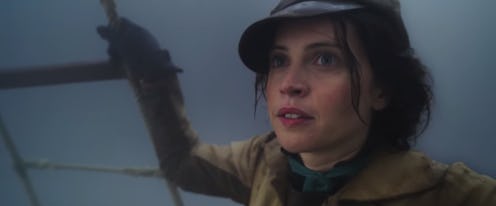Entertainment
Felicity Jones' 'Aeronauts' Character Has More Than One Fascinating Real-Life Inspiration

There was a time when the sky literally was the limit. The Aeronauts, which opens in theaters on Dec. 6, takes a look at that time and tells the story of two aeronauts who managed to break that limit in pursuit of new frontiers not just in aviation, but also in meteorology. But like many movies about specific historical events, it takes a few creative liberties along the way, and one of the main ones is the creation of one of its two main characters. Felicity Jones' Aeronauts character Amelia Wren doesn't actually exist, but she was inspired by two real-life aeronauts, both of whom were famous for their achievements and daredevil natures.
The Aeronauts centers on two aviation pioneers, James Glaisher (Eddie Redmayne) and Amelia Wren (Jones). Glaisher, a scientist, astronomer, and meteorologist, is interested not only in exploring the sky, but also in learning if it would be possible to predict the weather. To reach his goal of exploring the sky, he turns to Wren, who he believes is the only balloon pilot able to get him up high enough to conduct his research. Judging by the trailer, their sky-high trip becomes a real adventure as all sorts of things go wrong and they find themselves fighting to try to survive the dangerous expedition. It's the kind of adventure that seems a bit too sensational to be true, but trips like this one did in fact take place, only with two men at the helm, rather than a man and a woman.
According to Stylist, Jones' character, Amelia Wren, is based on balloonist Henry Coxwell, who accompanied the real-life Glaisher on his eventful atmosphere adventure in 1862. The two men rode a gas balloon into the atmosphere, with Glaisher seeking to learn as much as he could about its relationship to weather. Historians estimated that their trip took them at least 37,000 feet into the air, which is about the same cruising altitude for modern day jets and airliners.
There, they battled the elements and a thinning atmosphere, and would have died if not for Coxwell's quick actions after their balloon began to ascend too high, where the -20 degree Celsius weather wreaked havoc on their instruments. Coxwell was forced to climb out of the balloon to release a valve that would allow them to descend, and to top it off, he had to do it with his teeth, as his hands were frostbitten. The film's trailer shows alludes to a similar task, only it's undertaken by Wren rather than Coxwell. Per the BBC, this replacement of Coxwell left some of Glaisher's relatives "horrified." The Telegraph goes further, speaking with Keith Moore, the Head of Library at the Royal Society, London's academy of sciences. He told them, "It’s a great shame that Henry [Coxwell] isn’t portrayed because he performed very well and saved the life of a leading scientist."
Coxwell isn't the only inspiration for Wren's courageous, daredevil attitude, however. While he was present with Glaisher on the world record-setting trip, there was another figure behind Wren's creation. Per Movie Maker, following a screening at the Savannah College of Art and Design, director Tom Harper cited French aeronaut Sophie Blanchard as that secondary inspiration. "She was so different from James Glaisher, I thought… wouldn’t it be amazing, dramatically, to put those two very different people in the basket together?" he said. Blanchard, according to the Smithsonian Magazine, was the first professional female balloonist, who earned the favor of both Napoleon Bonaparte and Louis XVIII.
As for the real life Glaisher and Coxwell? They went on to survive their flight, which seems like something of a miracle, seeing as how they achieved their extremely high altitude without the aid of things like oxygen tanks or extreme cold weather gear. The only things they took with them besides their instrumentation? Pigeons for testing, and six bottles of brandy.
This article was originally published on